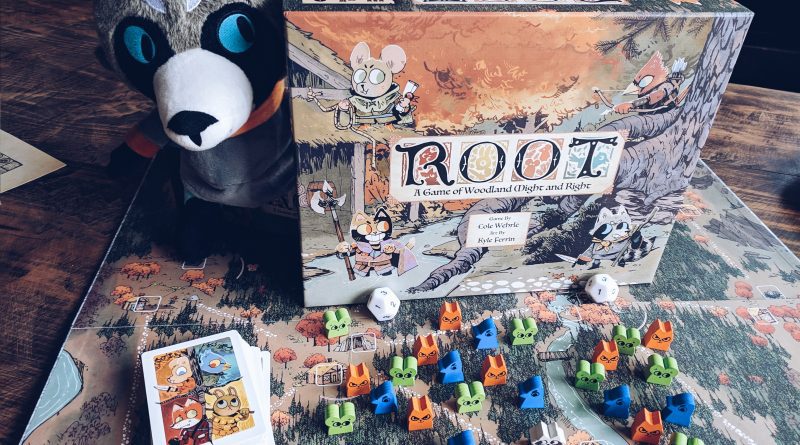Root
Today we’re checking out Root, an incredibly cute, deceptively complex, asymmetrical area control game by Leder Games. In Root, players take control of one of the four available factions of creatures, vying for dominance in the great woodland. The first faction to reach thirty victory points wins. How those points are accumulated varies drastically depending on the faction. Let’s take a look.
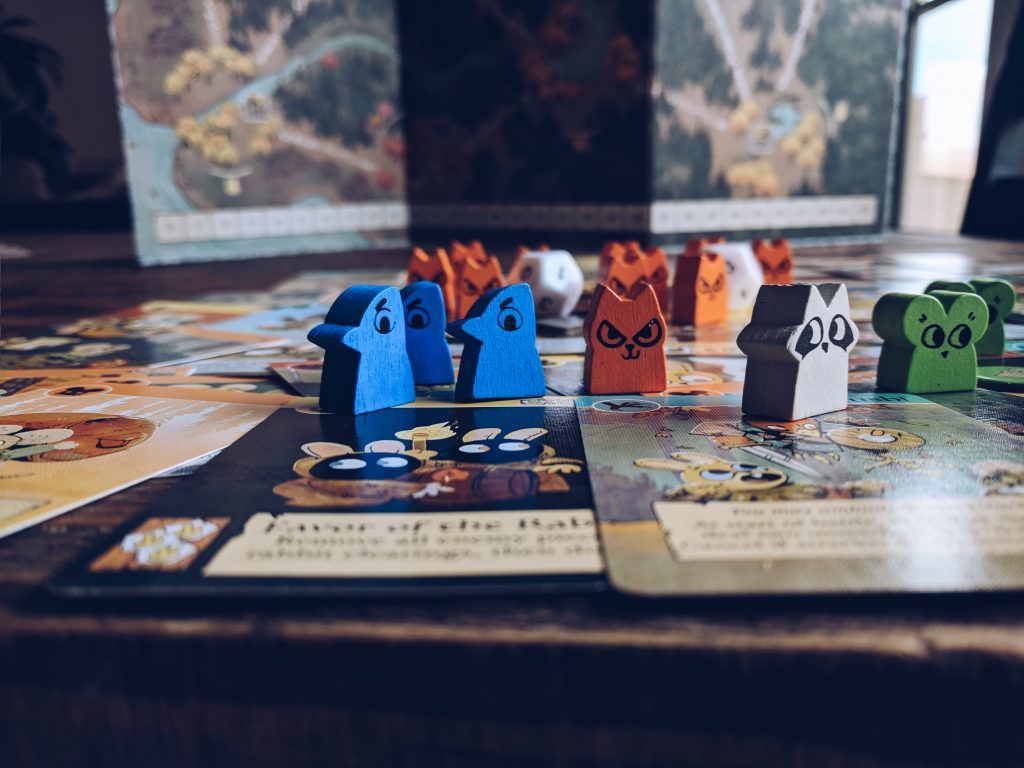
I have to be up front and say I am pretty biased towards the theme and setting of Root. I grew up reading Brian Jacques novels, and just seeing Kyle Ferrin’s work on the box art immediately drew me back to Mossflower Woods. That feeling just got stronger as I unpacked everything and played the game. Kyle’s art is absolutely phenomenal. It has a unique whimsical style that fits the theme perfectly. It’s so cute that you might be lured into thinking it is a light game. On the contrary, I would call Root a medium leaning into heavy game – more on that later.
To be clear, there isn’t any relation between the world of Root and the world of Redwall beyond the fact that both worlds feature societies of little woodland warriors. Before you ask, yes I am aware this comparison has been made a lot in reference to Root. If you read the books, you’ll understand why it immediately came to mind for so many. But I digress.
From a quality standpoint, all of the components are well made. The game board is double sided – a normal side and a winter side. The winter side isn’t only a visual overhaul either – it adds more variety to the game. Everything is printed well, and there are multiple ways to distinguish different suits and types of cards.The little wooden character meeples are not only full of character, but serve to differentiate the pieces for colorblind players.
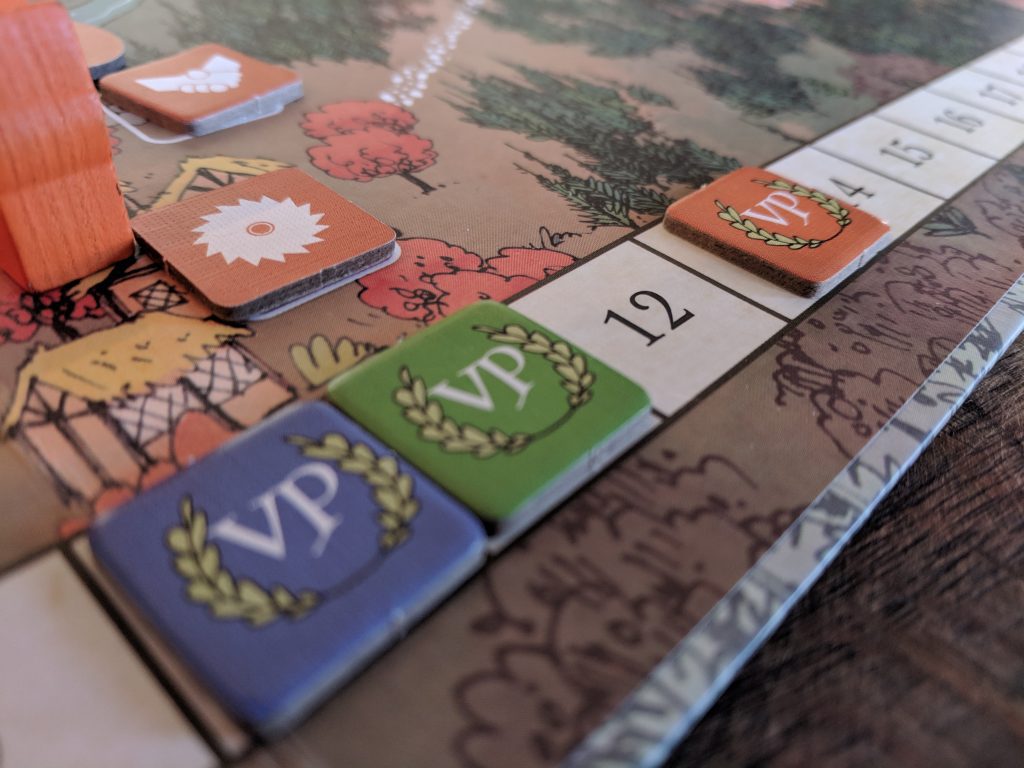
I’m going to be blunt in this next section, but I also want you to understand that I love this game to pieces. Nothing I say here is going to dissuade me from playing it over and over again. Okay. Here we go.
I do have a few more negative observations about the production of the game. Upon opening the box, I was greeted with some rule books, under which were player boards that fit so snugly into the box that I had to turn it upside down to get them out. The box could have been a few centimeters wider to allow some space for a finger. The insert that came with the game is just bad. It has a spot for cards, a spot for dice, and a big-ish spot for… everything else. Maybe it is asking too much, but I have come to expect modern games to take setup time and ease of access into consideration when designing inserts, and I feel like Leder games dropped the ball here. One last thing that surprised me was the fact that the dice included in the game were just plain white. In a game that is otherwise on point with visual appeal and table presence, I would have expected something a little more unique. Yeah. I know I’m being picky.
I was pretty intimidated by Root to begin with. What can I say, when a game has more than one rule book, it feels like it is going to be pretty complicated. Complicated isn’t bad per se, but if you’re like me, it means that it is going to take time to understand. Root has a BGG weight rating in the orange, and it is well deserved, but don’t let that discourage you from trying the game. The thing that the weight number doesn’t communicate is the fact that the complexity is almost completely driven by the game’s asymmetry. Each faction in Root plays completely differently and scores points completely differently. What this means is that, in order to get started, you only really have to know the details of your own faction, which in turn means you only really need to know about a fourth of the rules to jump in.
Speaking of the rules, the rule books are excellent. Notice the plural. We only really used the “Learning to Play” book for the majority of our games, and pulled out “The Law of Root” when we needed clarification – which only happened once or twice. Each player has their own setup instructions, which makes the setup process easier on the individual, but it does take a little bit of time – make sure you account for a good ten minutes for setup when planning your games.
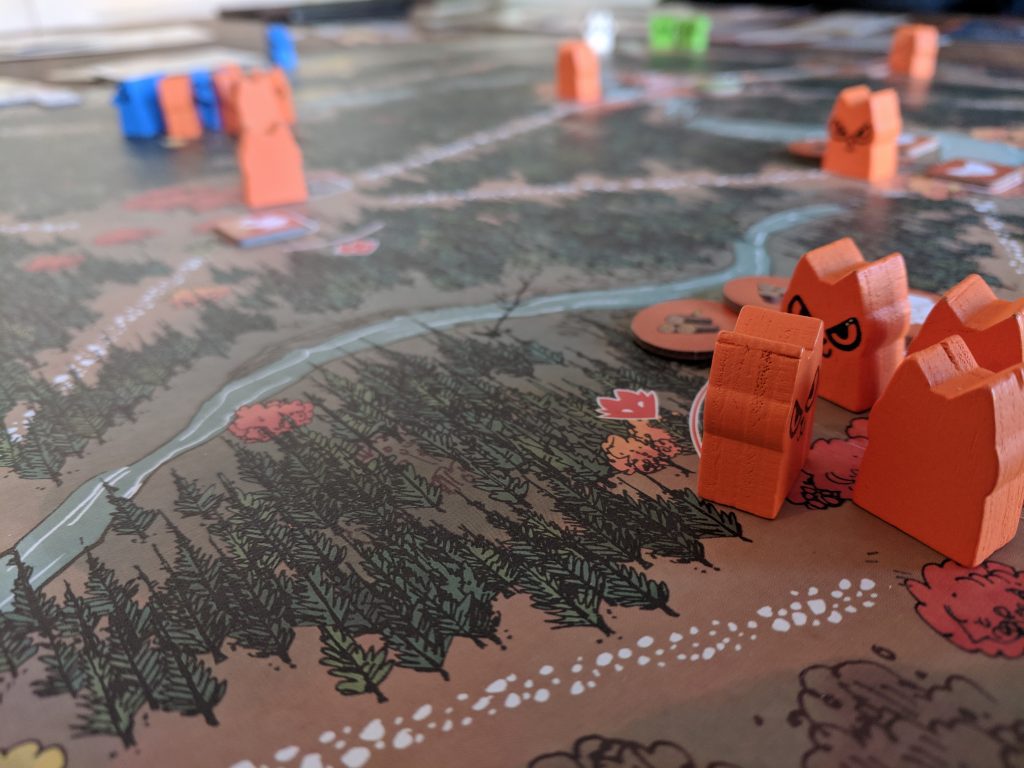
As you might have gathered by now, each faction has its own rules, its own mechanisms, and its own goals. In the interest of brevity, I won’t explain the intricacies of each faction here. I will, however, give a brief overview of the basic game mechanics, as well as a rundown of each faction to give you an idea of how the game plays. If you want more detail, Leder Games has made the rule books available online for your perusing pleasure.
A few things remain the same regardless of the faction you are playing. The board is divided into clearings, which are in turn separated into suits – Fox, Rabbit, and Mouse. Those clearings are connected by paths. Players can only move units to or from an adjacent clearing they “rule”, which means they have the majority of units and/or buildings in the clearing. The main deck of cards in the game are separated into the same suits as the clearings, with the addition of the Bird suit, which is wild. Usually the card suit you play has to match the location you’re using the card in. In addition, most cards can be crafted, gaining the player victory points or other bonuses.
When a player chooses to attack another player’s units, the defender gets a chance to play an Ambush card to gain a few free hits. The attacker then rolls two dice to determine how many hits the attacker and defender land. Typically, the attacker gets the higher number and the defender gets the lower number, up to the number of units the player has in that clearing. Players remove a number of units or buildings from the clearing based on the dice roll assigned to them. There are certain cards and abilities that affect battle by adding extra hits, and these effects are all clearly marked where applicable.
Here’s where it gets interesting. Every player’s turn is split into three phases. Birdsong, Daylight, and Evening. The specifics of these phases are detailed on the individual player boards, and are completely different depending on the faction.
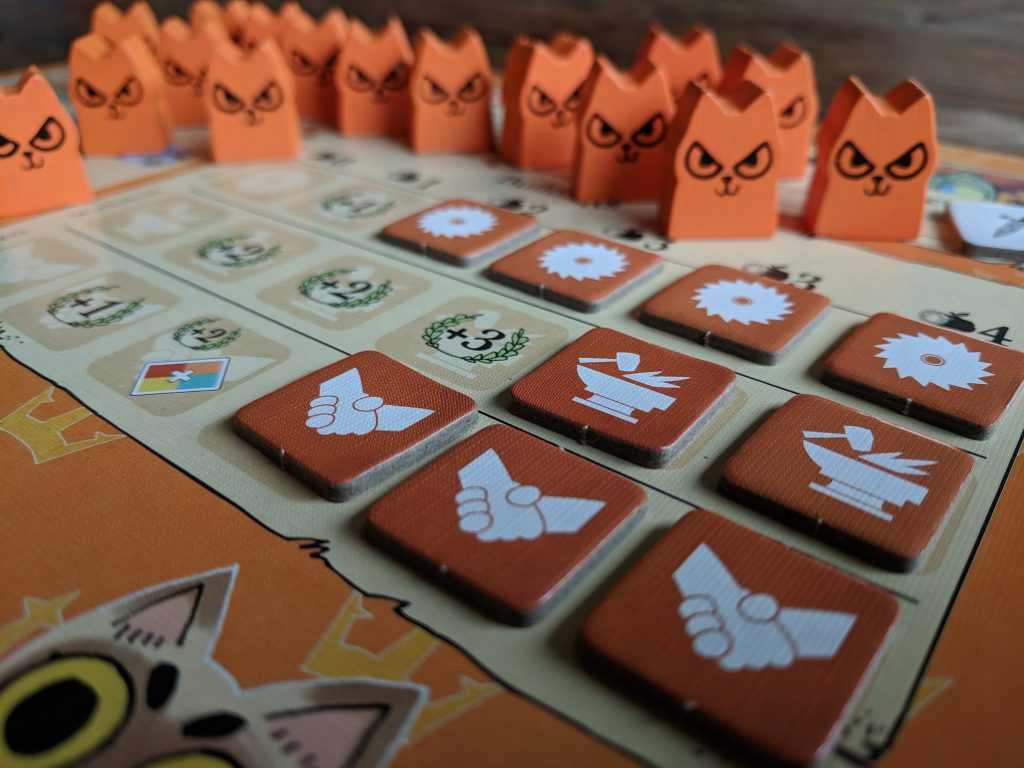
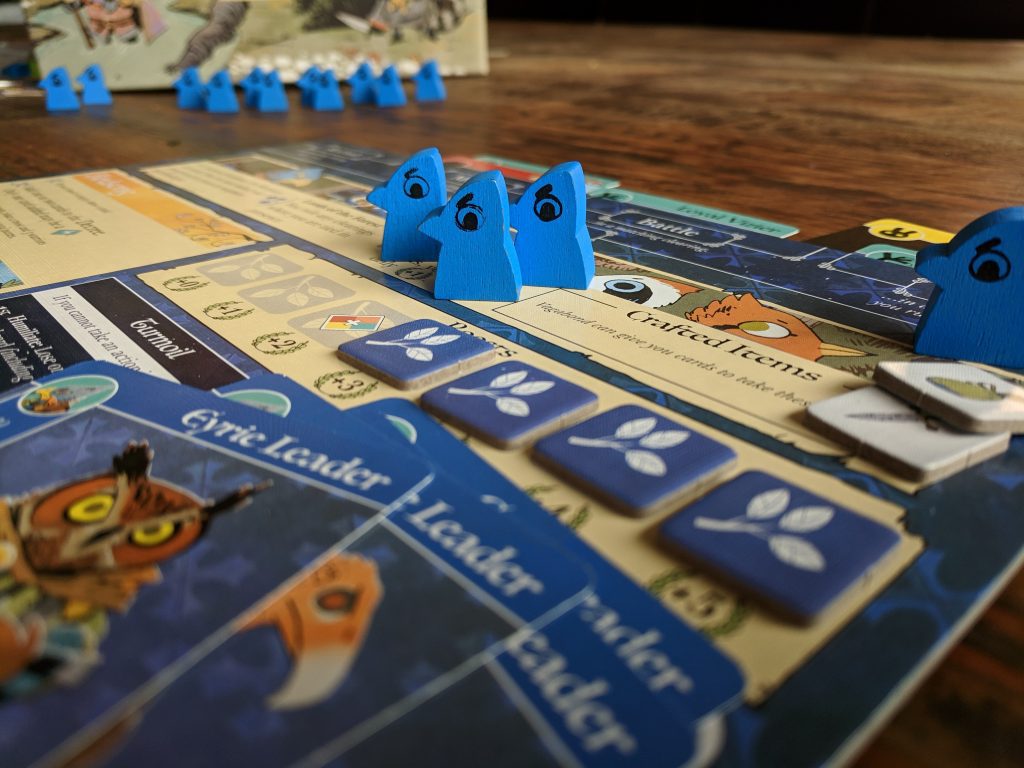
Marquise de Cat
At the start of the game, the Marquise de Cat are the current occupants of the woodland. They have units in all but one of the clearings in the game, and gain points by building in the areas they control. While they’re probably the easiest faction to play mechanically, I feel like they are difficult to win with.
Eyrie Dynasty
The Eyrie Dynasty (birds) occupies the one remaining clearing in the game. They gain points every turn from Roosts that they have on the board. They are, however, restrained by an action programming system called the Decree, which they must add one or two actions to every turn. This can snowball quickly if managed well, but it comes at a cost. If they ever can not complete an action, their Decree resets and they end up losing some victory points.
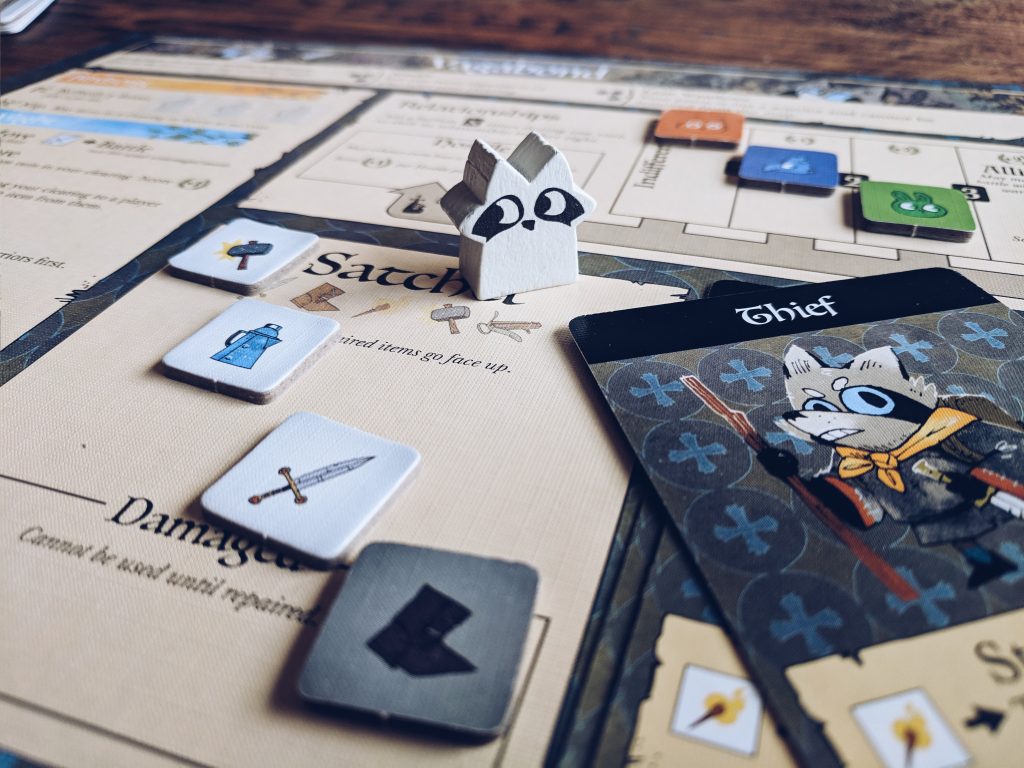
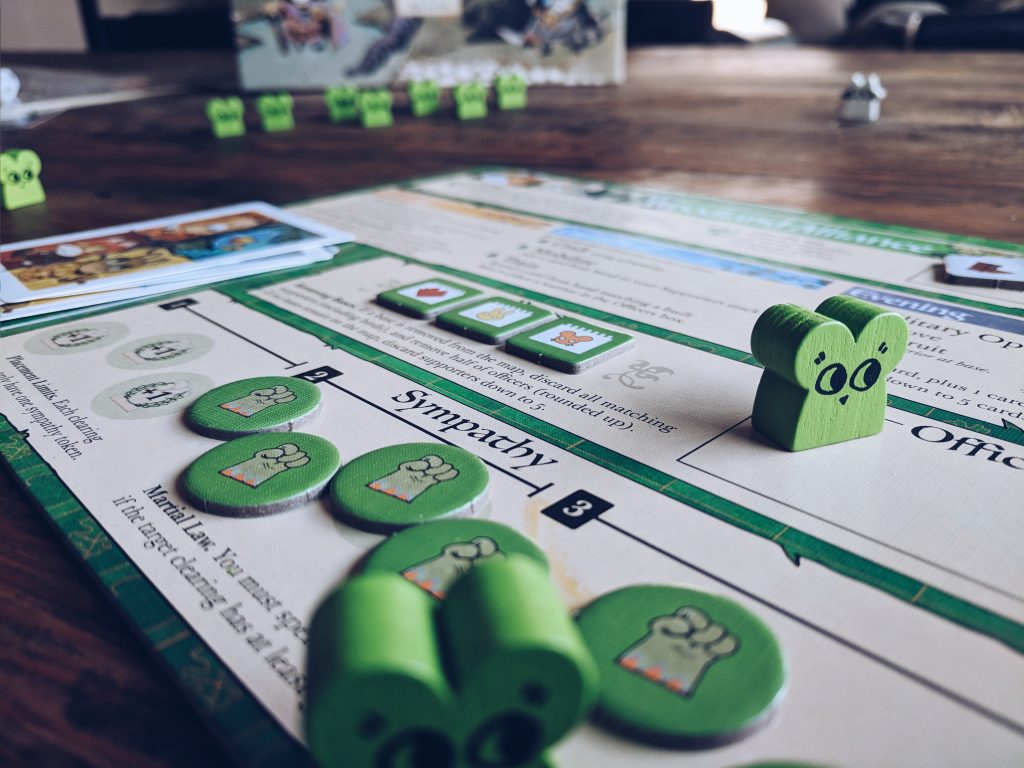
Woodland Alliance
The Woodland Alliance (mice) are the rebels of the bunch. They start with no board presence, and have to gain sympathy and supporters before causing revolts. They gain points by placing sympathy tokens on the board, and can gain points for the same token if it is ever removed. They tend to start very slowly, but can become a threat quickly as other factions focus on each other.
The Vagabond
The Vagabond is the lone wolf… err… lone raccoon. This little critter only has one immortal unit that can travel through the woods, trading items with other players. The Vagabond gains points through assisting other players, giving them cards, and eventually forming an alliance with them. The Vagabond can even completely tie its fate to another player’s provided that player is not already in the lead.
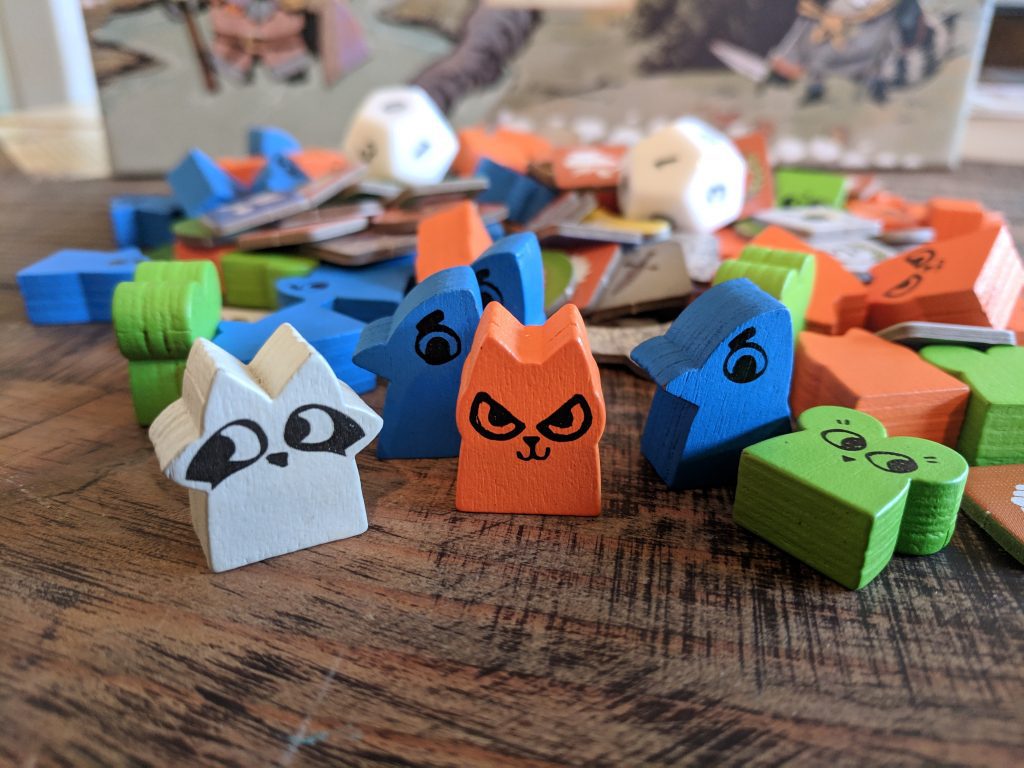
Leder Games surprised me in more than one way with Root. I thought it would be so convoluted and complicated that I wouldn’t be able to fully grasp it, but I was dead wrong. The complexity of the game came almost completely from the asymmetry. Information was dealt out in small doses, and I never felt like I didn’t understand what was going on. Once we all knew the basic rules, game length was surprisingly short – closer to 45 minutes than 90.
You might think the Vastly different play styles found in Root would create imbalance, but the opposite is true. After several plays of the game, I feel like every faction has an equal chance at success if played to their strengths. Granted, some factions are more mechanically difficult than others, but I don’t think that difficulty is significant enough to make one faction inherently stronger than another. That’s the mark of a really good asymmetric game. Leder didn’t shy away from the asymmetry. They didn’t just give players different decks and call it good. They made every aspect of every faction a unique experience, and it worked flawlessly.
Most importantly – it’s fun. Really fun. It’s one of the only longer games our group has ever decided to play multiple times in a row. In short, it’s a masterpiece. Sure, there are a couple of nitpicky things I can say about production but come on, this game is fantastic. And I hear it gets better. Leder Games has already released one expansion for Root, and more are on the way. I haven’t had the chance to play Riverfolk yet, but I’ll be sure to update you if I do.
Review copy provided by Leder Games
Publisher: Leder Games
Number of Players: 2-4
Age: 12+
Price at time of Review: $50
If you are interested in making a purchase based on this review, please consider using our affiliate link. If you do, we will receive a small commission.

